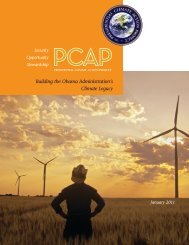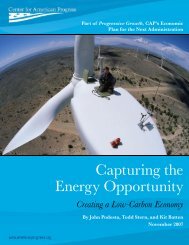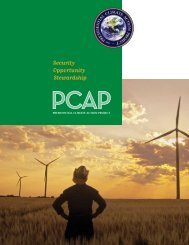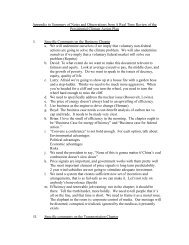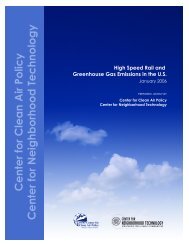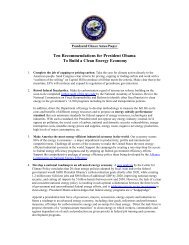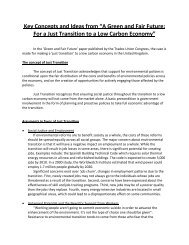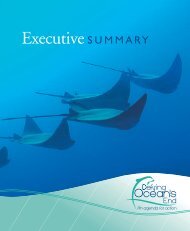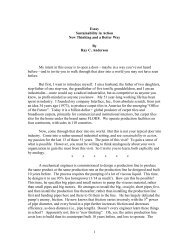Direct the EPA and DOE to collaborate with the American Truck Association todetermine appropriate incentives to increase the use of wide-base tires.B-09DOE and the EPA should require that tires for heavy-duty trucks are replaced with wide-basetires, and direct the agencies to collaborate with the American Truck Association to determineappropriate incentives to increase the use of these tires. <strong>PCAP</strong> Report 7:7.Background. This evaluation is limited to the second part of the proposal as quoted from the<strong>PCAP</strong> Report. According to test results from the National Transportation Research Center at theOak Ridge National Laboratory (ORNL), tractor-trailers operating with single, wider tiresrecorded improved fuel efficiency numbers between 7.2 to 10 percent when compared to rigsoperating on standard-sized dual tires. 216 The American Truck Association (ATA) is a privateentity.Statutes. Chapter II establishes that the President has a substantial role in planning energy andclimate change policy. Essentially, this proposal directs agencies, specifically the DOE and theEPA, to provide a report or information on a proposal related to energy and climate changepolicy. Providing incentives for the use of wide-base tires will decrease fuel consumption andthus reduce GHG emissions and dependence on foreign oil.The EPA also has a substantial role in developing climate change policy and works with privateindustry on a number of initiatives, as set forth in Proposal B-5 (statutes section).The DOE also has a substantial role in developing energy and climate change policy. Forexample, the DOE develops the least-cost energy strategy (LCES) which is included in thePresident’s National Energy Policy Plan. 217 The DOE is a member of almost every workinggroup, task force, committee and the like developing climate change policy; see, e.g., the <strong>Climate</strong>Program Policy Board, 42 U.S.C. § 2904(e), the Committee on Earth and EnvironmentalSciences, 42 U.S.C. § 2932, the Federal Coordinating Council for Science, Engineering, andTechnology, 42 U.S.C. § 6651, the Committee on <strong>Climate</strong> Change Technology, of which theSecretary is also the Chair, 42 U.S.C. § 13389(b), etc. The DOE is the primary agency for216 American Association for the Advancement of Science, Eureka Alert, Story Tips from ORNL, May 2008,available at http://www.eurekalert.org/pub_releases/2008-05/drnl-stf050108.php. The research is funded by the U.S.Dept. Of Energy’s Office of FreedomCAR and Vehicle Technologies. Oak Ridge National Laboratory’s Center forTransportation Analysis, News Release (Jan. 23, 2008), available at http://cta.ornl.gov/cta/News.shtml.217 41 U.S.C. § 13382(a) (The priorities of the LCES include energy conservation, stabilization and reduction ofGHGs, increasing energy efficiency, increasing the use of renewable resources, and reducing national oilconsumption.).CEES 53 | P age
implementing energy plans and programs, including those that develop and deploy energytechnologies. 218The DOE administers the Office of FreedomCAR and Vehicle Technologies which funded thestudy by ORNL that assessed the fuel efficiency advantages of new generation single wide-basedtires compared to conventional tandem tires. The mission of the Vehicle Technologies Program,as self reported, is to strengthen energy security, environmental quality, and economic vitalitythrough public-private partnerships. Program professionals work with industry leaders todevelop and deploy advanced transportation technologies with the goal of improving vehicle fuelefficiency and displacing oil with other fuels. The Program supports and works through the 21 stCentury Truck Partnership. Thus, this proposal falls within the mission of the EPA and DOE.Depending on the role of the ATA, there may be requirements pursuant to the Federal AdvisoryCommittee Act (FACA), 219 but nothing that would prohibit the action contemplated by thisproposal. For example, if the intent is to obtain information or viewpoints from individuals, asopposed to advice, opinions or recommendations from the group acting in a collective mode,FACA would not apply. In addition, the regularity of meetings is considered. The more static thegroup composition, the more likely FACA’s applicability will arise. If FACA applies, meetingsmust be announced and open to the public and various documents must be made available to thepublic (in addition to a number of administrative and reporting requirements). 220Authority over the Entities Subject to the Directive. The EPA is neither an executivedepartment nor an independent agency. In terms of the President’s authority over agencies,generally, the President’s authority over the EPA would be much the same as an executivedepartment. 221 The DOE is an executive department. 222 In regard to executive departments, it ispresumed that the President is constrained only by the requirement that he “not direct any actbeyond the bounds of an administrator’s legal authority.” 223This proposal essentially directs the agencies to provide a report or information on a potentialplan of action. This falls within the procedural supervisory authority over administrative officersas discussed in Chapter I. 224 This enables the President to demand information from, and engagein consultation with, agencies and their officers. This applies to all executive agencies across theboard and would include, for example, demanding reports on various issues, even reports thatsuggest a preferred policy position. 225218 See, e.g., 42 U.S.C. Chapter 84, Department of Energy.219 5 U.S.C. App. 2.220 See Proposal F.221 Boundaries Report, Chapter VI(1)(c).222 5 U.S.C. § 101.223 Peter M. Shane, Independent Policymaking and <strong>Presidential</strong> Power: A Constitutional Analysis, 57 GEO. WASH.L. REV. 596, 609 (1989); see also, Boundaries Report, Chapter VI (It is said that executive agency heads serve “atthe pleasure of the President” and therefore are under greater pressure to conform to the President’s policy goals.Endnote omitted.).224 See Boundaries Report, Chapter 6 (especially sections 1 and 4); see also, U.S. Const. Art. II, sect. 2.225 Kagan, supra at 2323-24.CEES 54 | P age
- Page 1 and 2:
THE BOUNDARIES OF EXECUTIVE AUTHORI
- Page 4 and 5:
This page left intentionally blank.
- Page 6 and 7:
Proposal IndexPage NumberA Establis
- Page 8 and 9:
D-01 Direct the federal Climate Cha
- Page 10:
I. IntroductionThis report is a fol
- Page 16 and 17: • The President shall not substit
- Page 18 and 19: 42, Chapter 77, Subchapter III expl
- Page 20 and 21: In addition, it delegates to the Pr
- Page 22 and 23: C. Presidential ProclamationsThere
- Page 24 and 25: 2. The developed country Parties an
- Page 26 and 27: A. Establish National Energy and Ca
- Page 28 and 29: the Nation, paying particular atten
- Page 30 and 31: The President should establish the
- Page 32 and 33: The President should establish the
- Page 34 and 35: This proposal is framed in terms of
- Page 36 and 37: partnership is working to reduce me
- Page 38 and 39: Good candidate to implement by exec
- Page 40 and 41: Executive Orders. There are 30 exec
- Page 42 and 43: Congress annually a comprehensive r
- Page 44 and 45: The Rural Utilities Services (RUS)
- Page 46 and 47: through the energy policy, has some
- Page 48 and 49: Direct the EPA to work with the Chi
- Page 50 and 51: private members: E.O. 12216, the Pr
- Page 52 and 53: next 20 years.” 181 From the publ
- Page 54 and 55: Direct the EPA to immediately begin
- Page 56 and 57: scientific judgment.” 199 Further
- Page 58 and 59: Direct the EPA to immediately grant
- Page 60 and 61: of climate change in California are
- Page 64 and 65: The ATA is a private entity, and as
- Page 66 and 67: and Bioenergy, establishes an inter
- Page 68 and 69: Authority over the Entities Subject
- Page 70 and 71: Direct the DOT to reconvene the Cli
- Page 72 and 73: Direct NASA to restore earth scienc
- Page 74 and 75: Direct the Council on Environmental
- Page 76 and 77: C. Improve Federal StewardshipDirec
- Page 78 and 79: 3. Background.OMB performs legislat
- Page 80 and 81: There are numerous executive orders
- Page 82 and 83: Federal Energy Management Executive
- Page 84 and 85: 1973; (3) E.O. 12845, Requiring Age
- Page 86 and 87: This proposal is consistent with an
- Page 88 and 89: 4. GHG reduction goals to transport
- Page 90 and 91: President, but the President “may
- Page 92 and 93: Declare that it is the responsibili
- Page 94 and 95: 1. Statutory provisions that establ
- Page 96 and 97: whenever feasible; and disposal or
- Page 98 and 99: species is listed as a threatened s
- Page 100 and 101: Determination of priorities which a
- Page 102 and 103: 3.2 Declaring that it is the respon
- Page 104 and 105: Management, (June 3, 1999) includes
- Page 106 and 107: economic, and other requirements of
- Page 108 and 109: environment.” Based on the polici
- Page 110 and 111: D. Protect American Taxpayers from
- Page 112 and 113:
special committees but are expressl
- Page 114 and 115:
Direct the federal Climate Change S
- Page 116 and 117:
The CCSP is an executive branch age
- Page 118 and 119:
E. Mobilize the MarketplaceDirect t
- Page 120 and 121:
pollutants. Further, courts give gr
- Page 122 and 123:
Direct the Council on Environmental
- Page 124 and 125:
methods, and data related to sustai
- Page 126 and 127:
F. Build Public-Private Partnership
- Page 128 and 129:
printed in the Federal Register and
- Page 130 and 131:
that officer or employee. Advisory
- Page 132 and 133:
A-06A-07B-01B-02B-03B-04B-05B-06B-0
- Page 134 and 135:
C-02.7C-02.8C-02.9C-03C-03.1C-03.2C
- Page 136 and 137:
Appendix AStatutes with Specific Te
- Page 138 and 139:
(C) assess the potential for the de
- Page 140 and 141:
15 U.S.C.A. § 657hTitle 15. Commer
- Page 142 and 143:
(5) Climate fluctuation and change
- Page 144 and 145:
(4) global data collection, and mon
- Page 146 and 147:
15 U.S.C.A. § 2932§ 2932. Committ
- Page 148 and 149:
implementation of any Federal actio
- Page 150 and 151:
(2) Projects eligible for funding u
- Page 152 and 153:
emissions associated with each type
- Page 154 and 155:
22 U.S.C.A. § 7902§ 7902. Reducti
- Page 156 and 157:
(c) Performance reviews and reports
- Page 158 and 159:
(3) Priority for integrated gasific
- Page 160 and 161:
[It is the purpose of this chapter
- Page 162 and 163:
(i) that no low greenhouse gas emit
- Page 164 and 165:
(3) prepare and transmit to the Con
- Page 166 and 167:
42 U.S.C.A. § 13384§ 13384. Asses
- Page 168 and 169:
(i) Selection of projects(3) In sel
- Page 170 and 171:
(1) In generalThe Secretary, in con
- Page 172 and 173:
(b) GoalsThe program shall have the
- Page 174 and 175:
Subchapter II. Energy Security thro
- Page 176 and 177:
Subchapter IV. Energy Savings in Go
- Page 178 and 179:
(B) to reduce emissions of covered
- Page 180 and 181:
§ 17334. Actions by overseas priva
- Page 182 and 183:
(5) be committed to minimizing admi
- Page 184 and 185:
Appendix BProclamations that Addres
- Page 186 and 187:
8) Proc. 7150, Nov. 20, 1998, World



